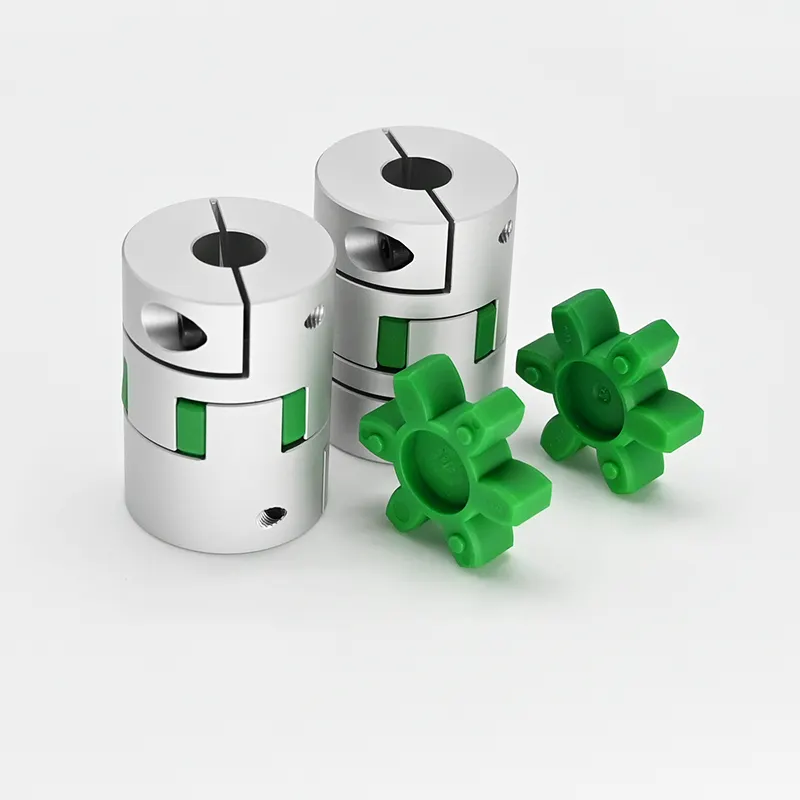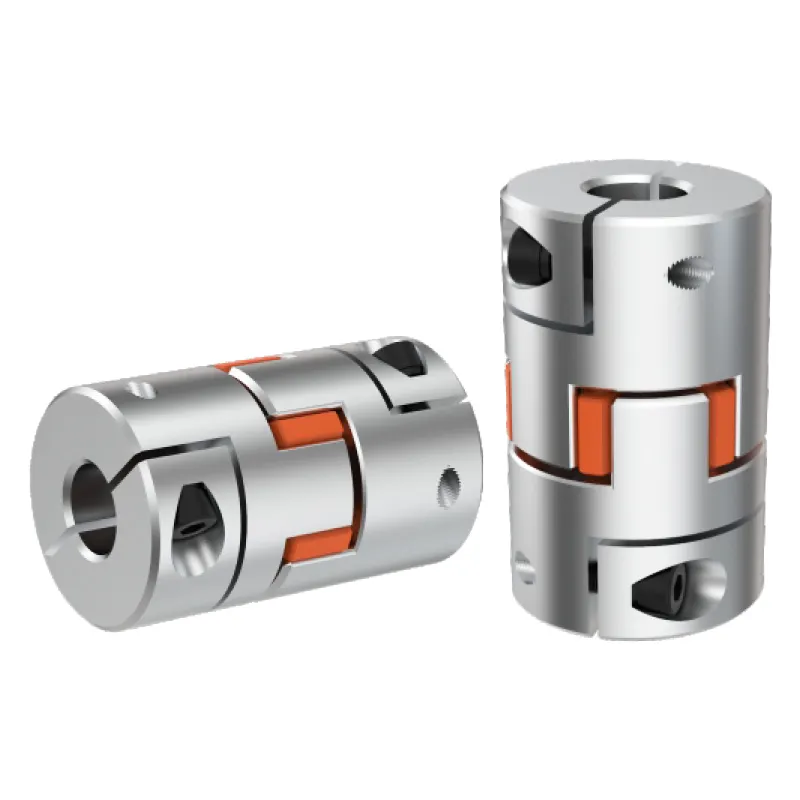Product Description
LMS Model Flexible Double flange type plum-shaped elastic coupling jaw coupling for pump
Description:
A jaw coupling is a type of general purpose power transmission coupling that also can be used in motion control (servo) applications. It is designed to transmit torque (by connecting 2 shafts) while damping system vibrations and accommodating misalignment, which protects other components from damage. Jaw couplings are composed of 3 parts: 2 metallic hubs and an elastomer insert called an element, but commonly referred to as a "spider". The 3 parts press fit together with a jaw from each hub fitted alternately with the lobes of the spider. Jaw coupling torque is transmitted through the elastomer lobes in compression.
The elastomer of the spider can be made in different materials and hardness, which allows the user to customize the coupling to best serve their application. Considerations for elastomer selection include ability to dampen vibration, ability to handle misalignment, operational temperature range, speed of equipment, and chemical conditions.
Features:
1.For heavy machinery;
2.Easy assblemly;
3.Cut off power when installation;
4.Can replace elastomer/spider withour moving driving and driven equipment.
Parameters:
Characteristics:
Flower-shaped elastic coupling has simple structure, small radial size, light weight and small moment of inertia. In medium and high speed applications, the plum-shaped elastic coupling works stably and reliably, and has good vibration damping, cushioning and electrical insulation properties. Plum-shaped elastic coupling has large axial, radial and angular compensation ability. High-strength polyurethane elastic components of plum-shaped elastic coupling are wear-resistant and oil-resistant, with large bearing capacity, long service life, safe and reliable, and coupling. No lubrication, no maintenance, continuous operation for a long time.
Plum-shaped flexible couplings are mainly suitable for starting, frequent reversing, medium and high speed, medium torque and high reliability requirements, such as metallurgy, mining, petroleum, chemical, lifting, transportation, light industry, textile, Pumps, fans, etc. Working environment temperature -35 ° C ~ +80 ° C, the transmission of nominal torque 25 ~ 12500Nm, the allowable speed of 1500 ~ 15300r / min.
Packing & shipping:
1 Prevent from damage.
2. As customers' requirements, in perfect condition.
3. Delivery : As per contract delivery on time
4. Shipping : As per client request. We can accept CIF, Door to Door etc. or client authorized agent we supply all the necessary assistant.
FAQ:
Q 1: Are you a trading company or a manufacturer?
A: We are a professional manufacturer specializing in manufacturing various series of couplings.
Q 2:Can you do OEM?
Yes, we can. We can do OEM & ODM for all the customers with customized artworks in PDF or AI format.
Q 3:How long is your delivery time?
Generally, it is 20-30 days if the goods are not in stock. It is according to quantity.
Q 4: How long is your warranty?
A: Our Warranty is 12 months under normal circumstances.
Q 5: Do you have inspection procedures for coupling?
A:100% self-inspection before packing.
Q 6: Can I have a visit to your factory before the order?
A: Sure, welcome to visit our factory.
/* January 22, 2571 19:08:37 */!function(){function s(e,r){var a,o={};try{e&&e.split(",").forEach(function(e,t){e&&(a=e.match(/(.*?):(.*)$/))&&1

Contribution of Jaw Coupling to Equipment Longevity
Jaw couplings play a vital role in enhancing the longevity and reliability of connected equipment in mechanical power transmission systems. The design and features of jaw couplings contribute to minimizing wear, reducing downtime, and protecting the equipment from harmful forces. Here's how jaw couplings contribute to equipment longevity:
- Shock Absorption: Jaw couplings have elastomeric spider inserts that act as shock absorbers, dampening vibrations and impact loads. This helps in protecting the connected equipment from sudden shocks and extends its operational life.
- Misalignment Compensation: In real-world applications, shaft misalignment is common due to thermal expansion, machine settling, or manufacturing tolerances. Jaw couplings can tolerate a certain degree of misalignment, reducing stress on bearings, seals, and other components of the equipment.
- Overload Protection: During overloads or torque spikes, jaw couplings can flex slightly, absorbing excess torque and preventing damage to the equipment. This overload protection feature prevents catastrophic failures and extends the life of mechanical components.
- Backlash Reduction: Excessive backlash in a power transmission system can lead to inaccuracies in motion control and wear on components. Jaw couplings are designed to provide low backlash, enhancing precision and minimizing wear on gears and other sensitive parts.
- Resilience to Contaminants: Jaw couplings often feature enclosed designs that protect the elastomeric spider from contaminants like dust, dirt, and moisture. This helps in maintaining the coupling's performance and preventing premature failure due to external elements.
- Low Maintenance: Compared to some other types of couplings, jaw couplings require minimal maintenance. Regular lubrication and inspection of the coupling can significantly extend its life and keep the connected equipment running smoothly.
- Easy Installation: The simple and compact design of jaw couplings makes them easy to install and integrate into various mechanical systems. Proper installation ensures efficient power transmission and reduces the chances of component damage.
Overall, jaw couplings contribute to equipment longevity by providing protection against shock loads, compensating for misalignment, preventing overloads, reducing backlash, and offering resilience to environmental factors. By selecting the right jaw coupling for the application and following proper maintenance practices, users can maximize the lifespan of connected equipment and improve the overall efficiency of their mechanical systems.

How do jaw couplings handle axial movement in rotating machinery?
Jaw couplings are primarily designed to handle angular and parallel misalignment between rotating shafts. While they are not specifically designed for axial movement compensation, they can accommodate a limited amount of axial movement under certain conditions.
The ability of a jaw coupling to handle axial movement depends on the specific design of the coupling and the type of elastomer spider used. The elastomer spider serves as the flexible element between the two coupling hubs and is responsible for transmitting torque and compensating for misalignment. Some jaw couplings have an elastomer spider with axial flexibility, allowing the coupling to accommodate minor axial movements while maintaining effective torque transmission.
However, it is essential to note that jaw couplings have limitations regarding axial movement. They are not designed for significant axial loads or axial displacements. Excessive axial movement can lead to premature wear and damage to the elastomer spider, reducing the coupling's performance and lifespan.
If an application requires significant axial movement compensation, other types of couplings may be more suitable. For instance, flexible beam couplings or bellows couplings are designed specifically to handle axial movement and are often used in applications where axial misalignment is a critical consideration.
In summary, while jaw couplings can handle a certain amount of axial movement, they are primarily intended for angular and parallel misalignment compensation. For applications with significant axial movement requirements, it is essential to consider coupling types explicitly designed for this purpose.

Materials Used in Manufacturing Jaw Couplings
Jaw couplings are commonly made from various materials, each offering different properties and suitability for specific applications. Some of the commonly used materials include:
- Polyurethane (PU): PU jaw couplings are known for their flexibility, high elasticity, and resistance to abrasion. They are ideal for applications requiring vibration dampening and shock absorption.
- Aluminum: Aluminum jaw couplings are lightweight, corrosion-resistant, and have good thermal conductivity. They are commonly used in low-to-medium torque applications.
- Steel: Steel jaw couplings offer high strength and durability, making them suitable for heavy-duty applications with high torque requirements.
- Stainless Steel: Stainless steel jaw couplings are resistant to corrosion and are often used in applications where there is exposure to moisture, chemicals, or harsh environments.
- Bronze: Bronze jaw couplings are known for their excellent wear resistance and low coefficient of friction, making them suitable for applications with high-speed and low lubrication.
- Acetal: Acetal jaw couplings provide good chemical resistance and low moisture absorption, making them suitable for applications where chemical exposure is a concern.
- Nylon: Nylon jaw couplings offer good strength, flexibility, and resistance to wear and chemicals, making them suitable for various industrial applications.
The choice of material depends on factors such as torque requirements, environmental conditions, operating speeds, and budget considerations. Engineers and designers select the appropriate material to ensure that the jaw coupling can perform optimally and withstand the demands of the application.


editor by CX 2024-04-15
